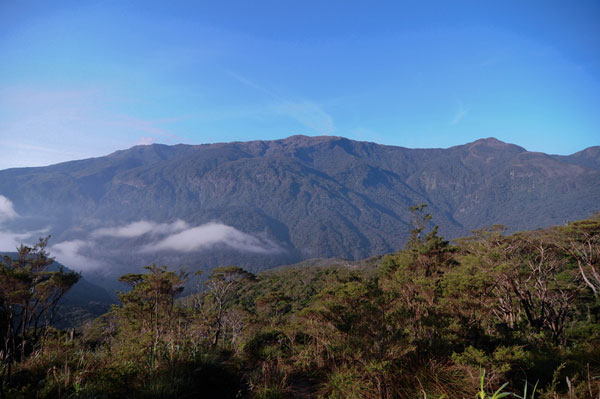
“Take nothing but pictures leave nothing but footprints, kill nothing but time.”
While the origin of this well known adage is dubious, the message can be clearly interpreted. It implores you to respect nature and in return, you and future generations will be rewarded with interminable natural treasures of the earth. The quote is quite simple to think of but why do some ignore its significance?
During the “Holy Week Climb” on April 17 to April 20, 2014, on Mount Halcon, 10 years after the moratorium, many things have been revealed through observations and interviews with the Mangyan porters-guides and even with some climbers coming from different places in the country and from as far as China. Ideas, principles, perceptions and respect towards nature and cultural minorities have changed.
Mount Halcon is one of the toughest mountains to climb in the Philippines. This is one rationale that pushes many to try and test its toughness. Many have tried but failed. Few have succeeded. It will take you two excruciating days to reach the summit and two days to return to the jump-off point; with its very rugged terrains and trails, a punishing unpredictable weather condition all year-round.
But what reclines its toughness is the bountiful flora and fauna, as the extensive studies of Dr. Emelina Mandia has shown: “One hundred and fifty-five species belonging to 78 families and 116 genera were recorded. Eighteen species represent new records for Mount Halcon. Eight species are endemic and on records are represented only by one or two collections.”
As observed during the climb, multiple campsites were made. In one of the interviews, the Mangyan porter-guides were asked by the climbers who they were serving, to hack certain vegetated areas so they can pitch their tents on site/s they wish; the mountain already has its designated and established campsites ever since, one in Aplaya (Camp I) and other in Dulangan (Camp II).
In another scenario, a climber asked his Mangyan guide-porter to slash an area because he is going to take a bowel; for such kind of practice by these climbers (not mountaineers, as I call them) they are the culprits that obliterate the bounty species of Mount Halcon.
Low impact mountaineering is a global trend that is widely advised, but for some individuals or group, high impact mountaineering is big bucks. Due to the charm of Mount Halcon, many wanted to conquer the mountain, even if it costs them big cash. During and after the moratorium (as of April 17-20, 2014),certain groups or individuals were charged Php 3,500 per head and as of April 25-28, 2014 it was cut-down to Php 2,500 per head. The amount covers transportation, ID for the climb, t-shirt, 1 meal, mangyan porter-guide for the group and permit (if they really get from the LGU of Baco; you are considered as “legal and documented climbers”).
Let’s make a simple calculation over this matter: Manila to Batangas P175.00/head (one-way), Batangas to Calapan P192.00/head for RO-RO boats (one-way), for fast ferry we have P250.00/head Fast Cat, and P370.00/head for Super Cat (both one-way), terminal ticket php 30.00/head Batangas port and P20.00 (Calapan port), Calapan to Jump off by Jeepney P3,500.00/group (two-way), permit from LGU of Baco P350.00/head (if legally), Mangyan porter/guide P500.00/day (for a group of 10, 2 mangyan porter/guide; for group of 20, four mangyan porter-guide) and lastly for the barangay P50.00.
What if your group comprises of 10 or 20 or 30? Or you offer a climb twice a week. You do the mathematics guys.
What does it entails, the bigger the number of the climbers the bigger the cash. As more climbers arrive, this individual/group that makes money out of Mount Halcon explored and opened another entry point to the mountain, one in Bangkatan and the other Banilad (San Ignacio), Bacothis resulted in easy access of the “pasaway” and in the course of this action it will endanger the solidity and balance of the ecosystem in Mount Halcon. The LGU of BACO, considered this as “illegal entry point” or “Backdoor” only Lantuyang and Bayanan (Mayabig) are recognized, even for the two barangays. The LGU of Baco and the two Barangays have formulated and regulated their ordinances regarding climbing Mount Halcon.
More climbers will make Mount Halcon unstable again (one reason of the moratorium which helps Mount Halcon restore its bounty), the trails are being pounded evidently making its soil slack, wider and exposed the elements of the earth. Plants are hacked and trashes are dumped secretly by these clap-trap climbers.
“Outreach program” is one of the common practices of certain groups or individuals in helping the community especially in the indigenous areas. For some, it’s just for community service (acquiring points for the promotional growth), others for experience, sensitivity and awareness, for the few its one way to win the heart of the community so that they can take advantage of whatever purpose they want to partake.
Based on some interviews and observations, conflicts between the Mangyans of different sitios became a problem now because of individuals/group that try to deceive the peaceful and gentle living of the Mangyans for their personal interests. They make false statements and accusations against the Halcon Mountaineers and even about the LGU of Baco to their advantage so they can manipulate the minds of peace and gentle-loving Mangyans (also the local climbers).
Why such practice is evident today? Is it for the love of Mount Halcon? Or is it the greed for money? As a one climber person says, “Halcon is just my playground.” But what if this playground of yours takes its toll because of the devastation brought by too much greed, what can you say about it?
Calling for all true mountaineers and environment-loving people, help save Mount Halcon, promote Low Impact Mountaineering. Halcon needs some rest.
RELATED STORIES
Mt. Halcon hike moratorium: Who really benefited?
On top of Mount Halcon at 70